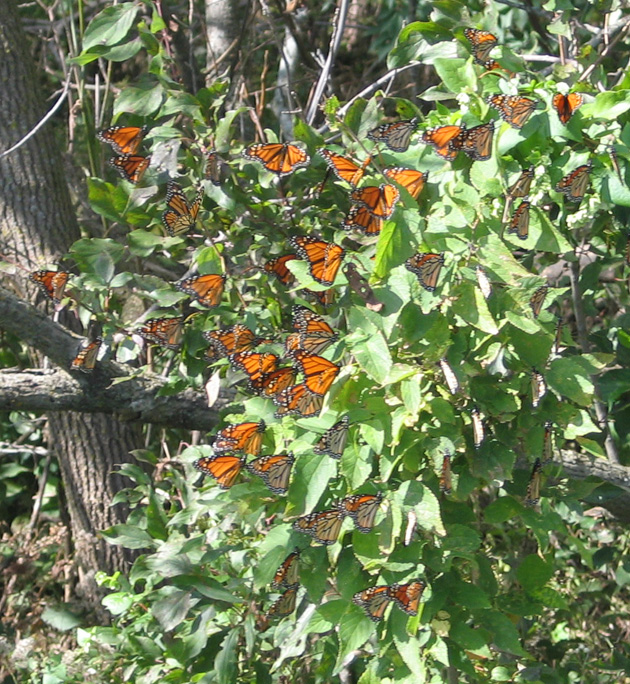
Monarch Butterfly Migration Over Central
Iowa
Fall 2010
By Robert D. Woodward

Late Monarch Roost Surprises at Neal Smith Refuge on September 24
August 27, 2010--During a one-hour visit to Neal Smith National Wildlife Refuge on this Friday, no monarch activity was noted. The early phases of the fall migration should be occurring in central Iowa during the coming week.
August 29--No sign yet of migrating monarch butterflies at Neal Smith National Wildlife Refuge. During a 45-minute visit to the refuge in mid-morning, no monarch activity was observed. Based on studies of migrations in recent years, this is not surprising as activity is more likely to pick up after September 1. At home in our butterfly garden in Altoona, a single monarch was observed in late morning.
September 1--Monarch butterfly movement across Neal Smith National Wildlife Refuge continues to be slow in developing this fall. During a 30-minute afternoon visit to the refuge on this day, no monarchs were observed. Last fall, 251 monarchs were counted on September 1; in 2006, the total was 155. Cooler overnight weather is predicted for the next few days and perhaps will spur more monarch movement.
September 2--Two monarchs were noted during a 30-minute observation in Neal Smith National Wildlife Refuge. One monarch visited our butterfly garden.
September 3--Strong winds today slowed any possible monarch movement at Neal Smith National Wildlife Refuge. At mid-day winds were blowing at 20 to 30 miles an hour from the northwest. Three monarchs were counted during a half-hour visit. The day was sunny with some clouds.
September 4--The monarch migration picked up in a major way in central Iowa on this Saturday. At Neal Smith National Wildlife Refuge, 130 monarchs were observed in 2 1/2 hours, but in the final hour monarchs were counted at the rate of more than one a minute as they moved south across a prairie hillside. They were traveling singularly and in pairs. Some were floating, some were speeding, some were chasing each other. The sky was mostly clear, and a light breeze was blowing from the northwest. Some of the monarchs appeared to be riding the wind. The movement on this morning was quite different from several previous days when few to no monarchs had been counted at the refuge. The cooler weather to the north in Iowa and Minnesota most likely was contributing to the movement. Later in the afternoon, intensive monarch movement was noted in and across our monarch garden in Altoona, Iowa. At one point, 35 monarchs were counted in a 10-minute span as they moved from north to south across the garden. Others were stopping for nectar on the flowers and to rest for a time. At least a hundred had passed by.
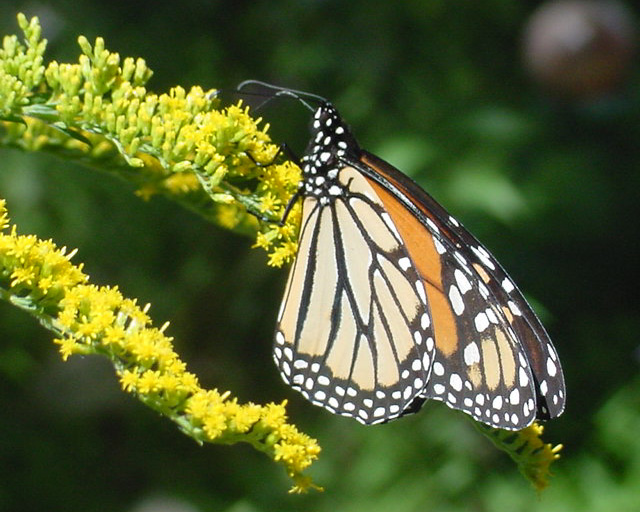
A Monarch Stops on the Goldenrod
September 5--Monarch movement continued at Neal Smith National Wildlife Refuge, but a wind of 15 to 20 miles an hour slowed the butterfly movement to the south. During two hours of observation, 81 monarchs were counted. A number of them were found in the savanna trail area of the refuge, where they were nectaring on wildflowers away from the wind. In past years, monarchs have roosted at night in oak trees along the savanna trail. Back home in our butterfly garden, another hundred monarchs were observed in one hour and a half as they passed through for short stopovers to take nectar from the wildflowers. Some of them were resting on the clumps of berries on a mountain ash tree.
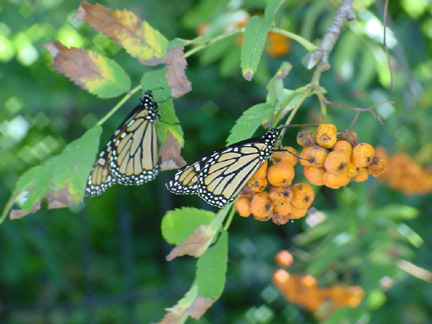
Monarch Visitors on September 5
September 6--A strong wind from the south slowed the monarch butterfly movement, but the butterflies continued to come into our garden in Altoona for nectaring and to rest. In several checks during the day, at least 35 monarchs were counted. At 6:15 p.m., for example, nine monarchs were still flying to and fro in the garden.
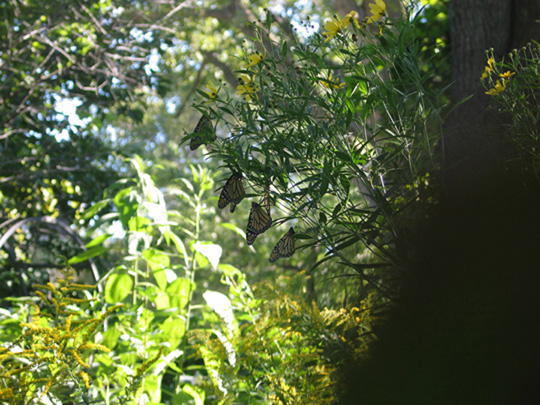
Four Monarchs Find a Resting Place in the Butterfly Garden
September 7--A one-hour morning visit to Neal Smith National Wildlife Refuge turned up 23 monarch butterflies in an area protected from a strong west-northwest wind. The monarchs were on a hillside in the savanna area of the refuge where they were nectaring on flowers and resting on tree limbs. Elsewhere in the refuge, no monarchs were noted.
September 8--Wednesday was a spectacular day for monarch watching over central Iowa. The weather was cool, the wind was slight, and the sky was clear, so the migrating monarchs were flooding down from the north. More than 1,000 monarchs were counted during afternoon observations at several points. At Neal Smith National Wildlife Refuge, the monarchs were everywhere--especially where varieties of sunflowers could be found. During three hours of observations, 868 monarchs were counted. They were favoring the nectar of tickseed sunflowers--a monarch choice this time of year. In addition, another 290 monarchs were observed along the roadways to and from the refuge, and at the end of the day, other monarchs were flying into our butterfly garden in Altoona for a rest.
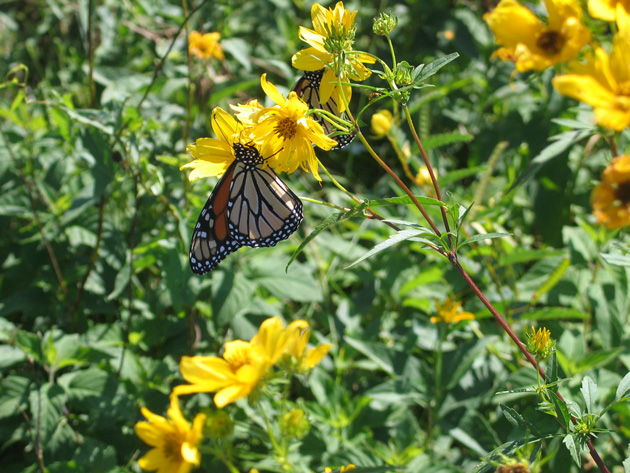
A Monarch Favors Tickseed Sunflower at Neal Smith Refuge
September 9--This was another wonderful day for observing the monarch butterfly migration over central Iowa. The monarchs were everywhere at Neal Smith National Wildlife Refuge and elsewhere. During four hours of observations at Neal Smith, a record 1,744 monarchs were counted as they nectared on the flowers and sought to continue their movement to the south. A brisk wind from the east southeast slowed the butterflies' flight. About 9:30 a.m., 265 monarchs were observed and counted in a large stand of tickseed sunflowers in the far north part of the refuge where they likely had spent their overnight hours. At other points in the refuge, monarchs appeared to be seeking out nectaring places as they continued their migration. Later in the afternoon, about 150 monarchs were counted in an hour as they flew into our butterfly garden in Altoona.
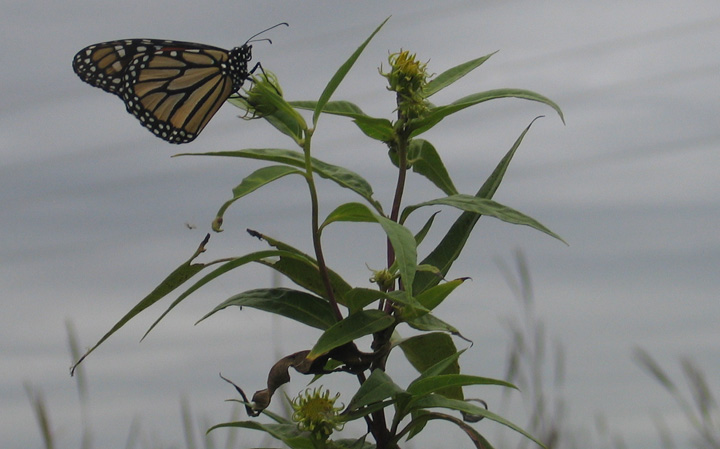
Monarch Seeks Out A Resting Place
September 10--The monarch movement today was curtailed significantly by a strong wind--20 to 25 miles an hour--from the east southeast. At midday, about 40 monarchs were counted on the west side of our butterfly garden on apple and mountain ash trees and other plants. They were resting away from the strong wind. At Neal Smith National Wildlife Refuge, 149 monarchs were counted.
September 11--The beauty of the monarch butterfly migration played out today across the hillsides and prairie of Neal Smith National Wildlife Refuge. A strong wind of 15 to 20 miles an hour from the northwest spurred the monarchs south in record-setting numbers on a clear day. The sight was amazing as they moved across the landscape in ones, twos, and threes or more. Some were flying low--10 feet or so above ground. Others were hundreds of feet above in a beautiful blue sky. They floated, they sped, they chased each other. Some stopped briefly on the wildflowers. In four hours of observations, 3,085 monarchs were counted. Many were counted from a single spot on a hillside in the refuge as they made their way south.
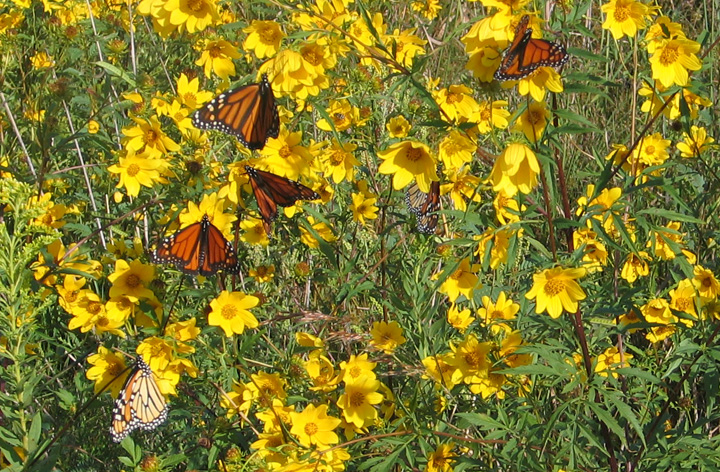
Monarchs Enjoyed the Tickseed Sunflowers on a Sunny Day
September 12--The direction of the wind changed from Saturday to today bringing a brisk 10-15 miles an hour wind from the southwest at Neal Smith National Wildlife Refuge. On Saturday a wind from the northwest had aided heavy migration movement, but the monarch trip south was slowed considerably today. In two hours of observations in the late morning, 217 monarchs were counted. Mostly, they were nectaring on wildflowers in various areas of the refuge while showing few attempts to head on south.
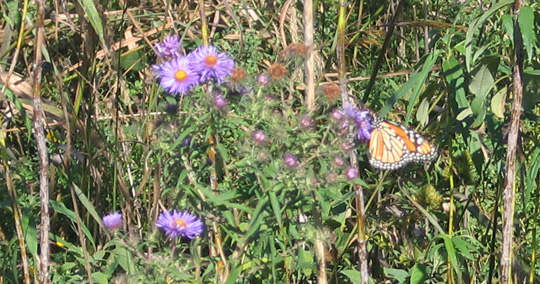
Traveling Monarch Finds Purple Aster
September 13--The weather was warm, a slight breeze was blowing, and monarch butterfly activity was limited at Neal Smith National Wildlife Refuge on this day. During one hour of observation in mid-afternoon, 63 monarchs were counted. They were nectaring primarily on tickseed and sawtooth sunflowers.
September 14--After slowing down for two days, the migration of monarch butterflies picked up again at Neal Smith National Wildlife Refuge. Today was a clear, warm, and beautiful day with a slight breeze. The monarchs were coming into the refuge in the north and stopping along the way on sawtooth and tickseed sunflowers for nectaring. In 2 1/2 hours in the late morning, 640 monarchs were counted.
September 15--Monarch butterflies were continuing to come in from the north at Neal Smith National Wildlife Refuge. A brisk wind of 10 to 20 miles an hour was blowing from the southeast, and the monarchs were struggling as they moved across the sunflowers where they were nectaring. In two hours of observations in the afternoon, 568 monarchs were counted.
September 16--After several days, the wind returned to the north northwest at Neal Smith National Wildlife Refuge, stirring up more monarch butterfly activity. In two hours and 45 minutes during the morning and early afternoon, 650 monarchs were observed in various areas in the refuge. Some were nectaring primarily on sawtooth sunflowers while perhaps half of them were speeding or floating to the south over the fields. The day was cool and mostly cloudy with a wind of 15 to 20 miles an hour. On occasions when the sun came out, the monarchs seemed to be more active. At one point in the northern part of the refuge, the sun brought on a flurry of monarch movement.
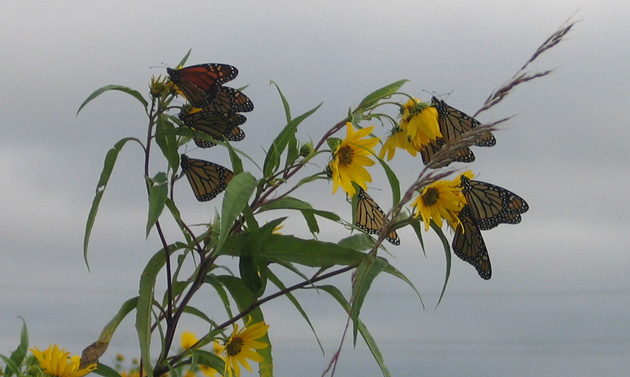
Monarchs Wait Out the Strong Winds on a Sunflower
September 17--Monarchs continued to be observed at Neal Smith National Wildlife Refuge. Mostly they were nectaring on sunflowers in areas of the refuge. In 2 1/2 hours in the late morning, 515 monarchs were counted. The day was mostly clear with a wind of 5 to 10 miles an hour from the south southeast.
September 18-19--Rain and cooler weather over central Iowa shut down the movement of migrating monarch butterflies.
September 20--The day was sunny and warm with a strong wind from the south southeast at 20-25 miles an hour. During a late afternoon visit to Neal Smith National Wildlife Refuge, 80 monarchs were observed in an hour. Several were noted fighting the wind, but most were found in the savanna trail area of the refuge. There they were nectaring on wildflowers on a forested hillside and stopping to rest on the branches of oak trees.
September 21--A morning visit to Neal Smith National Wildlife Refuge indicated monarchs were still active in central Iowa. During a visit of 1 1/2 hours, 139 monarchs were observed. Many of them were seen in the savanna area of the refuge, but others were fighting a strong wind from the southwest--at 10 miles an hour or more. The morning was partly cloudy to cloudy with the temperature in the 60s. By midday, however, the weather changed, and rain halted the monarch activity in central Iowa.
September 23--During a visit of one hour and 15 minutes in the morning to Neal Smith National Wildlife Refuge, 65 monarchs were observed. Once again, many of them were found in the savanna area of the refuge where they were nectaring on hillside wildflowers and resting on the branches of oak trees. By afternoon, rain and wind slowed monarch activities although several were noted in our butterfly garden.
September 24--Late-arriving monarch butterflies put on an astounding spectacle at Neal Smith National Refuge. Just when their numbers had been diminishing for about a week due to rain and strong winds, the monarchs exploded on the scene with a major roost estimated at 800 or more on the western side of the refuge. Another 350 were seen moving south over the refuge during four hours of observation. Their strong activity followed heavy rains during the previous day and overnight, and the movement suggested the monarchs' travels had been delayed in the north for some time. The day was partly cloudy and cool with a brisk west wind. Around the roost by late morning, butterflies in the hundreds could be seen flying in the area and resting on trees and plants along a half-mile area near a creek bed. A wonderous moment in monarch watching.
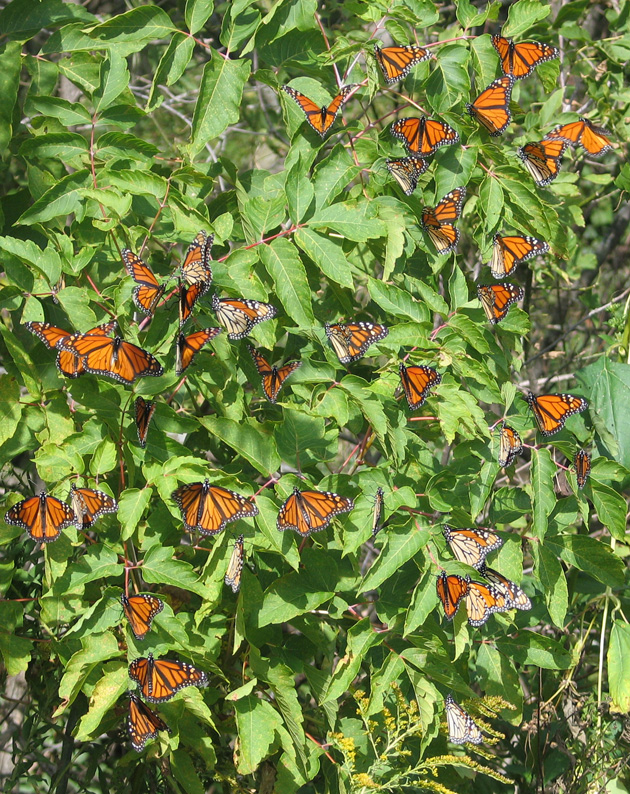
Monarchs Were Everywhere As They Rested at the Refuge
September 25--Heavy rainfall and cooler weather put a damper on any monarch butterfly movement in central Iowa. A mid-morning check of the area at Neal Smith National Wildlife Refuge where hundreds of monarchs had been roosting yesterday found no butterflies there now.
September 26--Rain on Saturday halted monarch movement, but on Sunday, monarchs still were being seen at Neal Smith National Wildlife Refuge. During a two-hour visit in the morning, 201 monarchs were counted. The day was clear and cool with a temperature in the low 50s. A mild northwest breeze of 5 miles an hour was blowing. Most of the monarchs were observed nectaring on sunflowers.
September 27--Things were different today at Neal Smith National Wildlife Refuge. In two hours of observations in the afternoon, 24 monarchs were counted, suggesting the migration may be winding down. What was apparent was the remaining monarchs seemed to be changing their nectaring habits to the purple New England asters rather than sunflowers. At least 20 of the 24 monarchs were found on New England asters. The day was sunny with a temperature in the 70s and a brisk wind of 10-plus miles an hour from the southwest.
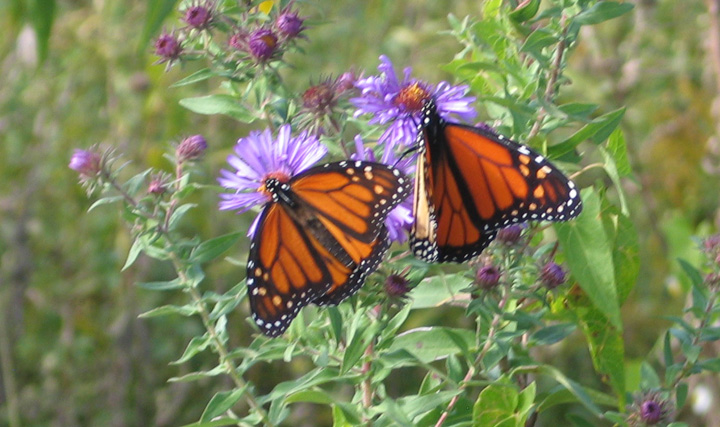
Two Monarchs Share the New England Asters
September 28--The day was sunny and cool at Neal Smith National Wildlife Refuge. A wind was blowing from the north northwest at 10 miles an hour. During a one-hour visit, only five monarchs were observed. Several of them were nectaring on New England asters.
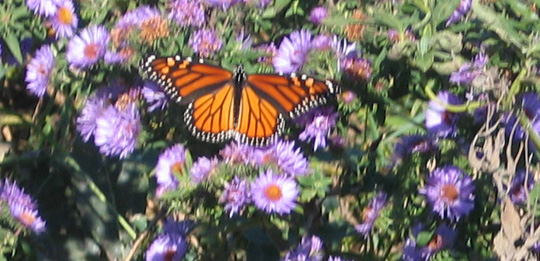
One of a Few Monarchs Seen During the Day
September 29--During a half-hour visit to Neal Smith National Wildlife Refuge, three monarchs were observed, indicating the migration for this fall across central Iowa has ended except for some possible stragglers. The day was clear and the temperature in the 70s. The wind was blowing from the southwest at 10-plus miles an hour.
September 30--Ten monarchs were observed during a one-hour morning visit to Neal Smith National Wildlife Refuge. Most were nectaring on New England asters. The day was clear and sunny with a light breeze.
October 3--The big bluestem grasses are turning autumn brown, the sawtooth sunflowers are going to seed, and the New England asters are still flashing their bright purples. But the monarch butterfly migration has ended at Neal Smith National Wildlife Refuge. During a one-hour visit, no monarchs were observed for the first time this fall. A morning temperature of 39 degrees and a frost warning in central Iowa signaled an end to the monarch season.
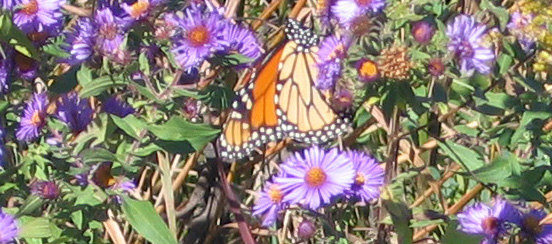
One of the Season's Last Monarchs on September 30